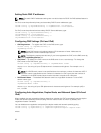
6
Configuring CMC
Chassis Management Controller enables you to configure properties, set up users, and alerts to perform
remote management tasks.
Before you begin configuring the CMC, you must first configure the CMC network settings to allow CMC
to be managed remotely. This initial configuration assigns the TCP/IP networking parameters that enable
access to the CMC. For more information, see Setting Up Initial Access to CMC.
You can configure CMC using Web interface or RACADM.
NOTE: When you configure CMC for the first time, you must be logged in as root user to execute
RACADM commands on a remote system. Another user can be created with privileges to configure
CMC.
After setting up the CMC and performing the basic configurations, you can do the following:
• Modify the network settings, if required.
• Configure interfaces to access CMC.
• Configure LCD display.
• Set up chassis groups, if required.
• Configure servers, I/O module, or front panel.
• Configure VLAN settings.
• Obtain the required certificates.
• Add and configure CMC users with privileges.
• Configure and enable e-mail alerts and SNMP traps.
• Set the power cap policy, if required.
NOTE: The following characters cannot be used in the property strings of both the CMC interfaces
(GUI and CLI):
• &#
• < and > together
• ; (semicolon)
Viewing and Modifying CMC Network LAN Settings
The LAN settings, such as community string and SMTP server IP address, affect both the CMC and the
external settings of the chassis.
If you have two CMCs (active and standby) on the chassis that are connected to the network, the standby
CMC automatically assumes the network settings of the active CMC in the event of failover.
When IPv6 is enabled at boot time, three router solicitations are sent after every four seconds. If external
network switches are running the Spanning Tree Protocol (STP), the external switch ports may be blocked
79


















